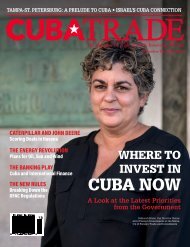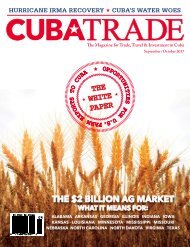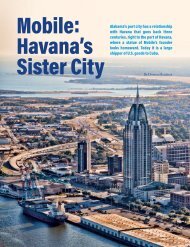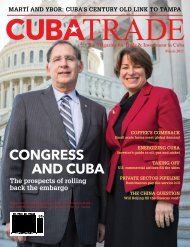CubaTrade-May2017-Flipbook
You also want an ePaper? Increase the reach of your titles
YUMPU automatically turns print PDFs into web optimized ePapers that Google loves.
Top left: Coco taxis take passengers along the Malecon seawall, Havana<br />
Top right: Friends ride past Havana's Gran Teatro on a motorcyle<br />
Middle: Visitors enjoy a taxi ride and a little American nostalgia<br />
Bottom right: In rural Cuba, horse drawn carts sometimes outnumber cars<br />
Bottom left: Tourists arrive at their destination by private luxury bus<br />
201 categories of self-employment occupations, including 15<br />
related to transporting people.<br />
In 2010, the Cuban government issued 43,702 cuentapropista<br />
licenses for carrying passengers; by 2015, that number had<br />
jumped to 72,077. In 2015 alone, 13,086 licenses were issued<br />
to cars, followed by trucks (2,987); jeeps (1,042); SUVs (972);<br />
microbuses (650); and minivans (87).<br />
Perhaps reflecting the high cost of gasoline as well as exhorbitant<br />
car prices in Cuba, by 2015 there were more licenses issued<br />
for horse-drawn carriages transport people (13,336) than for cars<br />
(13,086), followed by those for Havana’s ubiquitous Bici-Taxi<br />
bicycles (12,125).<br />
Autos used as taxis controlled by the state, 1985-2014<br />
Source: Overall statistics (1985-2009) and provincial statistics (2010-2014) issued by the National Office<br />
of Statistics and Information (ONEI).<br />
Source: Source: Overall Overall statistics statistics (1985-2009) (1985-2009) and provincial and statistics provincial (2010-2014) statistics issued (2010-2014) by the National Office<br />
issued by the National of Office Statistics of Statistics and Information and Information (ONEI). (ONEI)<br />
Licenses issued for private sector self-employed<br />
transportation, 2010-2015<br />
Licenses issued for private sector self-employed transportation, 2010-2015<br />
Transportation mode 2010 2015<br />
Growth rate<br />
(%)<br />
Trucks 1,949 2,987 53.26<br />
Registered vehicles, 2000-2014<br />
CUBA'S POTENTIAL AUTO MARKET<br />
These figures illustrate Cuba’s desperate need for transportation,<br />
yet Cuban citizens have limited options when it comes to buying<br />
a car. Ad hoc solutions ranging from shared rides to horse-drawn<br />
carts are clearly not enough to meet demand.<br />
This should present huge opportunities in the retail auto<br />
market and in car rentals to tourists. Indeed, conditions are ripe<br />
for a widescale opening of the vehicle market—even to the point<br />
of building auto assembly plants on the island. However, profound<br />
policy changes must first take place in Cuba’s commercial<br />
structure.<br />
This process has already begun. In 2011, the Cuban government<br />
took the first step of authorizing the sale and purchase of<br />
cars between Cubans and foreign residents. Subsequently, Decree<br />
320, approved in December 2013, completely liberalized the sale<br />
and purchases of cars. This law established that Cuban citizens<br />
“could purchase through state commercial entities internal<br />
combustion cycles, motorbikes, cars, rural cars, vans, SUVs and<br />
mini-buses.” For the first time in 51 years, Cubans could buy a<br />
new or used motor vehicle without restrictions. However, a major<br />
obstacle emerged: very high prices.<br />
Cuba’s strategy has been to maintain strict control over<br />
public transport, using retail auto sales and the tourism transport<br />
sector to finance public transport. The problem is that extremely<br />
high prices for cars keeps the number of transactions way down.<br />
In June 2014, six months after Cuba lifted restrictions on car<br />
sales, state-run CIMEX had sold only 50 autos and four motorbikes.<br />
With average sticker prices of 23,759 CUC (about $28,000)<br />
in a country where buying power is low and purchases must be<br />
made in cash, it’s no wonder sales are depressed. Studies indicate<br />
that had a policy of more accessible prices been applied, more than<br />
250,000 cars could have been sold on the island up to today.<br />
CONCLUSIONS<br />
Vehicle types 2000 2014 14/10<br />
Automobiles 216,461<br />
Motorcycles 232,888<br />
Growth<br />
rate(%)<br />
231,25<br />
4 14,793 6.83<br />
211,39<br />
5 -21,493 -9.23<br />
Trucks Licenses issued for 140,955 private sector 66,492 self-employed -74,463transportation, -52.83 2010-2015<br />
Jeeps 40,613 28,897 -11,716 -28.85<br />
Growth rate<br />
Vans Transportation mode 21,822 20,920 2010 -902 2015 -4.13(%)<br />
Buses Trucks 30,326 18,356 -11,970 1,949 2,987 -39.47 53.26<br />
Panel trucks 15,455 17,061 1,606 10.39<br />
Trailers 27,996 15,505 -12,491 -44.62<br />
Sports cars 13,529 7,598 -5,931 -43.84<br />
Microbuses 19,617 5,746 -13,871 -70.71<br />
759,66 623,22 -136,43<br />
Source: Total Overall statistics (1985-2009) 2 and 4 provincial 8 statistics -17.96 (2010-2014)<br />
issued by the National Office of Statistics and Information (ONEI)<br />
With the rapid growth in tourism and more demand from<br />
Cuban citizens, it’s no surprise that the private sector now dominates<br />
the taxi business, with 17,790 taxis plying the Cuban streets<br />
as of 2015—eight times larger than the state fleet.<br />
Source: Based on statistics from the National Registry of Vehicles of the Ministry of Transportation<br />
(MITRANS)<br />
Figure 3. Land transport in Cuba, millions of passengers, 1963-2015<br />
Cuba’s transport sector is facing stronger demand than ever<br />
before. With passenger transport at the same level it was 43 years<br />
ago and few private vehicles—90 percent of them in use for more<br />
than 30 years—Cuba needs more than 8,300 businesses just to<br />
return to mid-1980s levels.<br />
In the coming years, Cuba will receive the largest avalanche<br />
of tourists—both domestic and foreign—in its history. The<br />
purchasing power of Cubans has increased considerably thanks to<br />
remittances and growing private sector.<br />
To satisfy demand, the government must change its 2013<br />
pricing policy for the sale of cars to private individuals and replace<br />
it with more accessible prices for Cuban citizens. It should<br />
also introduce a system of credit to allow at least partial financing<br />
for car purchases.<br />
Building a domestic market for car sales would generate<br />
thousands of new jobs, create hundreds of workshops for maintenance<br />
and repair and lead to multimillion-dollar sales of fuels,<br />
spare parts and accessories. More importantly, this would relieve<br />
the passenger transportation crunch, leading to a more dynamic,<br />
efficient economy. And finally, strong domestic demand could attract<br />
foreign investors hoping to establish factories for cars suited<br />
to the reality of the Cuban market. H<br />
MAY 2017<br />
CUBATRADE<br />
81
















